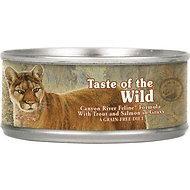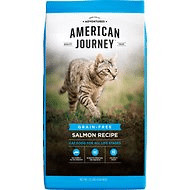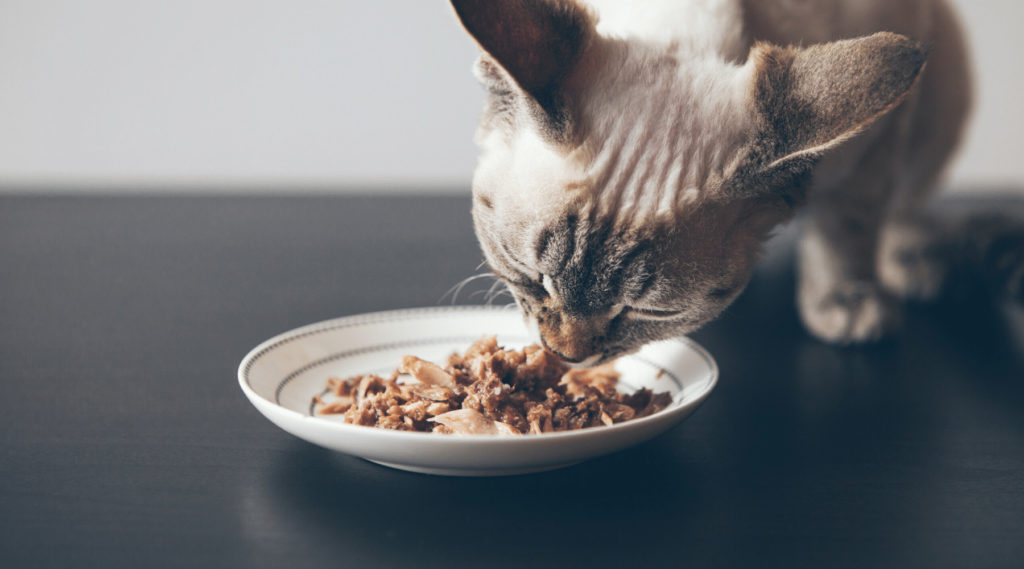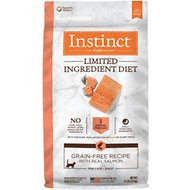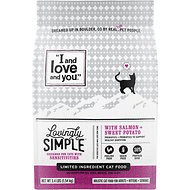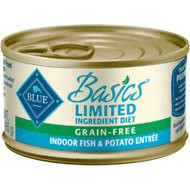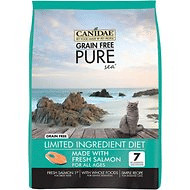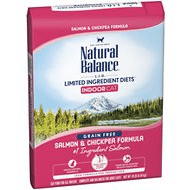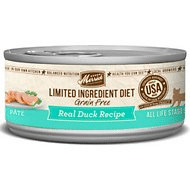Contents
- Best Food for Cat with Rodent Ulcers:
- What Are Rodent Ulcers in Cats?
- How Can Changing Your Cat’s Diet Help?
- What to Look for in a Good Cat Food for Rodent Ulcers
- How Do We Make Our Recommendations?
- The 9 Best Foods for Rodent Ulcers
- 5 More Top-Rated Cat Foods for Rodent Ulcers
- I and Love and You Lovingly Simple Limited Ingredient Diet Salmon & Sweet Potato Dry Food
- Blue Buffalo Basics LID Grain-Free Indoor Fish & Potato Entrée Adult Canned Cat Food
- Canidae Grain-Free Limited Ingredient Diet PURE Sea Salmon Dry Cat Food
- Natural Balance LID Indoor Grain-Free Salmon & Chickpea Formula Dry Food
- Merrick Limited Ingredient Diet Grain-Free Real Duck Pate Recipe Canned Food
- Frequently Asked Questions
You’re probably familiar with some of the most common afflictions in house cats. Hairballs, food sensitivities, and the occasional battle wound from fighting with another cat are all things you’d be able to identify on your own. But what on earth is a rodent ulcer?
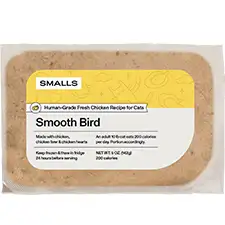
Smalls Smooth Bird Fresh, Human-Grade Cat Food
- Natural sources of taurine
- High in protein
When you hear the phrase “rodent ulcer” you might understandably think it’s some horrible disease contracted by contact with rodents. In actuality, however, the disease has nothing to do with rodents. Rather, it is an allergic reaction caused by any number of things that results in painful lesions forming on the cat’s lips, chin, and inside the mouth. Though it is not the most common condition seen in cats, it is bad enough that you should at least familiarize yourself with it so you can identify it quickly and seek treatment for your cat at the first sign of symptoms.
In this article, we’ll explore the subject of rodent ulcers in depth to learn what they are, what symptoms they produce, and how to treat them. You’ll also learn about the role diet plays in rodent ulcer treatment and see our top picks for the best food for cat with rodent ulcers.
Best Food for Cat with Rodent Ulcers:
- Smalls Smooth Bird Fresh, Human-Grade Cat Food
- Taste of the Wild Canyon River Grain-Free Canned Food
- American Journey Salmon Recipe Grain-Free Dry Food
- Instinct by Nature’s Variety Limited Ingredient Diet Grain-Free
- I and Love and You Lovingly Simple Limited Ingredient Diet Salmon
- Blue Buffalo Basics LID Grain-Free Indoor Fish & Potato Entrée
- Canidae Grain-Free Limited Ingredient Diet PURE Sea Salmon
- Natural Balance LID Indoor Grain-Free Salmon & Chickpea Formula
- Merrick Limited Ingredient Diet Grain-Free Real Duck Pate Recipe
What Are Rodent Ulcers in Cats?
The name “rodent ulcer” is very misleading because this condition has nothing to do with contact with rodents. It can, however, be triggered with other organisms like fleas. Technically, rodent ulcers are signs of a condition called feline eosinophilic granuloma complex. This term refers to three different types of skin lesions in cats: eosinophilic plaque, eosinophilic granuloma, and indolent ulcers.
The exact cause of eosinophilic granuloma complex in cats is unknown, but some studies suggest that it is a hypersensitivity reaction (essentially an allergic reaction) to certain triggers. For cases that are recurrent or chronic, an allergic reaction is the more likely the cause. Some studies suggest, however, that the underlying cause may be at least partially inheritable or genetic.
Here are some of the potential causes of eosinophilic granuloma complex:
- Allergies to fleas
- Chemicals in plastic or rubber bowls
- Food sensitivity or allergy
- Exposure to environmental pollutants
- Synthetic ingredients in cat litter
- Compromised immune system (such as FIV)
Eosinophilic granuloma lesions often form inside the cat’s mouth, so you may not notice them immediately. Unfortunately, this condition can be very severe, and damage caused by the lesions may be permanent if the condition isn’t treated quickly. This is why it is important to at least familiarize yourself with the disease and its symptoms so you can get your cat treated as quickly as possible.
When it comes to diagnosing a rodent ulcer, cat symptoms include:
- Lesions forming inside the cat’s upper lip
- Swelling of the lip and around the ulcerated area
- Lesions forming on the body, most commonly the belly
- Demarcated, flat areas of swelling and redness
- Hair loss from the ulcerated area
- Severe itching around the ulcerated area
- Ulcers forming on the hind legs and foot pads
Now that you have a better understanding of this health problem, you may be wondering which is the best option for rodent ulcer treatment. In the next section, we’ll talk about treatment options and explore how changing your cat’s diet might help.
How Can Changing Your Cat’s Diet Help?
The first step in diagnosing eosinophilic granuloma or rodent ulcer is to rule out other causes for the ulcers. Your veterinarian will want to make sure that your cat’s problems aren’t being caused by a fungal, bacterial, or viral infection. Some of the diagnostic tests your veterinarian may perform during diagnosis may include:
- Internal organ function tests
- Skin scrape for mites
- Complete blood count (CBC)
- Skin impression test
- FeLV and FIV test (should be negative)
- Fungal culture test
If all of these tests are negative, your veterinarian will move on to discussing potential treatment options for rodent ulcers. The most common treatments for eosinophilic granuloma are steroids or antibiotics, maybe both. Though bacteria may not be directly involved in causing rodent ulcers, secondary bacterial infections are very common and should be treated as well.
If you’re wondering about at-home treatment for rodent ulcer, however, there may be some options for you to consider. First and foremost, you’ll want to identify the trigger that caused your cat to develop a negative reaction. Once you’ve identified it, all you need to do is prevent your dog from coming into contact with it in the future and then take steps to heal his ulcers and restore proper health. If your cat’s issues are caused by a food allergy or sensitivity, changing your cat’s diet could help with treatment.
So, what role does diet play in restoring your cat’s health?
Changing your cat’s diet can help him recover from rodent ulcers and boost his immune system to prevent a recurrence – it can also give your cat the strength and energy he needs to heal the ulcers themselves. In cases where your cat’s rodent ulcers are not seasonal and you suspect a food allergy as the trigger, performing a food trial to identify and then avoid the food allergen is a necessary step.
What to Look for in a Good Cat Food for Rodent Ulcers
When it comes to shopping for the best food for rodent ulcers, quality is key. The higher the quality of the food, the more digestible it will be which means that your cat gets more of the essential nutrients he needs to recover. If you’re not sure exactly what is causing your cat’s allergy, you should still switch to a limited ingredient diet (LID) for at least 8 weeks until your cat’s symptoms resolve. At that point you can continue feeding the limited ingredient food or try to identify the ingredient your cat is allergic to so you can switch to a more affordable food free from the problem ingredient.
Here are some of the things we look for in a good cat food for rodent ulcers:
- High-quality, natural ingredients. Low-quality ingredients like fillers and by-products are likely to trigger food allergies or make existing sensitivities worse. Choose a cat food that contains wholesome, natural ingredients and no by-products.
- Free from common food allergens. The most common food allergens for cats are chicken, beef, fish, and dairy products. Grains are not the most common allergen, so you should only worry about a grain-free diet if your cat has been diagnosed with a grain allergy.
- Limited number of ingredients. The fewer ingredients in your cat’s food, the fewer things he could potentially react to. Look for a recipe with a novel animal protein as the first ingredient with a short list of other main ingredients (aside from supplements)
- Anti-inflammatory ingredients. Rodent ulcers are an inflammatory condition marked by redness and swelling around the ulcerated areas. To help your cat recover, find a cat food rich in anti-inflammatory ingredients like omega-3 and omega-6 fatty acids.
- Antioxidants for immune system support. In addition to reducing inflammation, omega-3 fatty acids can help boost your cat’s immunity. Antioxidants are also good for the immune system and may help your cat heal.
Now that you have a better understanding of what rodent ulcers are, what causes them, and how changing your cat’s diet might be able to help, you’re ready to see our recommendations for the best food! But first, read on to see how we make our recommendations.
How Do We Make Our Recommendations?
All of the cat foods we recommend are evaluated in accordance with AAFCO food nutrient profiles which outline the minimum nutritional needs of cats in various life stages (kitten or adult). In order to determine whether a cat food meets these requirements, just look for an AAFCO statement of nutritional adequacy on the package. It will be on the label and will look something like this: [X Product] is formulated to meet the nutritional levels established by the AAFCO Cat Food Nutrient Profiles for all life stages. After establishing that the product is complete and balanced, we go on to a more in-depth analysis of the ingredients.
Here are some of the requirements for a cat food to receive our recommendation:
- A source of high-quality animal protein as the first ingredient
- At least 30% crude protein for kittens and at least 26% for adults
- A minimum of 9% crude fat for kittens and adults
- A balance of omega-3 and omega-6 fatty acids, primarily from animal sources
- A rich blend of nutrients from natural sources and supplements, as needed
- Limited carbohydrate content from digestible sources (like whole grains and veggies)
- No low-quality fillers, by-products, or artificial additives (preservatives, dyes, or flavors)
Before getting into our top picks for the best rodent ulcer cat food, we want to make it clear that changing your cat’s diet is NOT a substitute for veterinary care. You need to take your cat to the vet to determine the underlying cause of his lesions and to find the proper treatment. If your veterinarian confirms that food allergies are the issue, at that point changing your cat’s diet could help resolve the symptoms and prevent them from returning.
The 9 Best Foods for Rodent Ulcers
If your cat’s rodent ulcers are related to a food allergy or sensitivity, removing the offending food ingredient from your cat’s diet is essential. A limited ingredient diet made with a novel source of protein is the best option for a food trial and you should continue it for at least 8 weeks before introducing potential allergens to identify the cause of your cat’s food allergies.
Here are our top picks for the best food for cat with rodent ulcers to use in a feeding trial:
| Our 2023 Picks: Best Foods for Rodent Ulcers | |||
Smalls Smooth Bird Human-Grade Fresh Cat Food Delivery
|
CHECK PRICE | ||
Taste Of The Wild Canyon River Grain-Free
|
CHECK PRICE | ||
American Journey Salmon Recipe Grain-Free
|
CHECK PRICE | ||
Instinct By Nature’s Variety Limited Ingredient Diet Grain-Free Recipe
|
CHECK PRICE | ||
I And Love And You Lovingly Simple Limited Ingredient
|
CHECK PRICE | ||
Blue Buffalo Basics LID Grain-Free Indoor Fish
|
CHECK PRICE | ||
Canidae Grain-Free Limited Ingredient Diet
|
CHECK PRICE | ||
Natural Balance LID Indoor Grain-Free Salmon
|
CHECK PRICE | ||
Merrick Limited Ingredient Diet Grain-Free Real Duck
|
CHECK PRICE | ||
Smalls Fresh Bird Cat Food Delivery
Overall Best Food for Rodent Ulcers: When it comes to treating serious health problems in cats, high-quality nutrition is important. Real, natural ingredients provide rich sources of key nutrients, not to mention immune-boosting antioxidants. Smalls fresh cat food is a great choice because not only does it use only the best natural ingredients, but it is prepared in small batches to ensure nutritional integrity. This food has a higher moisture content than traditional dry food, making it easier for your cat to digest. Plus, it can be customized to your cat’s specific nutrient and calorie needs, making it easy on you. Simply provide some information about your cat’s age, breed, size, and lifestyle and choose from the recipes available. You’ll start receiving shipments of fresh, high-quality cat food right to your door.
- Pros: Fresh food delivered to your door, high-quality natural ingredients, rich in protein and moisture, highly digestible, rich in nutrients and antioxidants, anti-inflammatory ingredients, probiotics
- Cons: Higher cost than average cat food, only two protein options to choose from
Taste of the Wild Canyon River Grain-Free Canned Food
Most Popular Cat Food for Rodent Ulcers: Because there are so many different cat food brands out there, it can be difficult to choose one. If you’re really not sure what to buy, you can always trust a popular brand like Taste of the Wild that uses high-quality, natural ingredients in all of their recipes. This Taste of the Wild Canyon River Grain-Free Canned food is a particularly good option for cats with rodent ulcers because it contains novel proteins like trout, ocean fish, and smoked salmon as well as other highly digestible natural ingredients. This formula is rich in anti-inflammatory omega-3 fatty acids and contains fresh fruits and vegetables as rich sources of antioxidants and other essential nutrients. Overall, this formula provides 8% protein and 3% fat at 82% moisture which translates to a dry matter calculation of over 44% protein and nearly 17% fat.
- Pros: Novel animal proteins, rich in omega-3 fatty acids, natural sources of antioxidants, highly digestible recipe, complete and balanced nutrition, chelated minerals for optimal nutrient absorption
- Cons: Not a single-source protein recipe, main source of fat is plant-based (sunflower oil)
American Journey Salmon Recipe Grain-Free Dry Food
Most Affordable Cat Food for Rodent Ulcers: Good cat food doesn’t come cheap and cheap cat food generally isn’t good. There is always an exception to the rule, however, and American Journey is an affordable brand you can trust. This American Journey Salmon Recipe Grain-Free Dry Food is a great option for cats suffering from rodent ulcers because it features a novel source of premium animal protein and one rich in omega-3 fatty acids: fresh salmon and salmon meal. This recipe also contains menhaden fish meal and eggs for supplemental proteins with grain-free, digestible carbohydrates like tapioca and peas. It contains fresh fruits and vegetables as anti-inflammatory ingredients and rich natural sources of antioxidants, not to mention key vitamins and minerals. Overall, this recipe offers high-quality nutrition that is complete and balanced for cats.
- Pros: Novel animal proteins, rich in omega-3 fatty acids, highly digestible natural ingredients, complete and balanced, natural sources of antioxidants, probiotics for healthy digestion
- Cons: Not a single-source protein recipe, contains some plant protein (pea protein)
Instinct by Nature’s Variety Limited Ingredient Diet Grain-Free Recipe with Real Salmon Adult Dry Cat Food
Best Food for Rodent Ulcers and Sensitive Stomach: If your cat suffers from food allergies or has a sensitive stomach on top of suffering from rodent ulcers, it is even more important to choose a limited ingredient diet made with a single source of novel animal protein. That is exactly what this Instinct by Nature’s Variety Limited Ingredient Diet Grain-Free Recipe with Real Salmon Adult Dry Cat Food provides. It contains salmon meal as the first ingredient and a concentrated source of premium animal protein. In terms of the other main ingredients, there are only 7 others, including several sources of omega-3 and omega-6 fatty acids as well as digestible grain-free carbohydrates. Overall, this recipe provides 37.5% protein and 17% fat with 3% fiber at 517 calories/cup.
- Pros: Limited number of ingredients, single source of animal protein, rich in omega fatty acids, digestible grain-free carbohydrates, chelated mineral supplements, complete and balanced
- Cons: Significantly more expensive than typical kibble, main source of fat is plant-based (canola oil)
5 More Top-Rated Cat Foods for Rodent Ulcers
The recipes above are our top picks for the best food overall for cats with rodent ulcers and our favorites for popular and affordable recipes, as well as one for sensitive stomachs. If these recipes don’t seem quite right for your cat, don’t worry! There are many other options to choose from. Here are five more limited ingredient recipes featuring high-quality sources of novel animal protein:
I and Love and You Lovingly Simple Limited Ingredient Diet Salmon & Sweet Potato Dry Food
This limited ingredient diet from I and Love and You features several premium sources of novel animal protein such as fresh salmon, menhaden fish meal, and salmon meal. All three are rich in omega-3 fatty acids which helps balance out the omega-6 content of the sunflower oil. This formula is highly digestible, made with a limited number of natural ingredients, including grain-free carbohydrates like peas, sweet potatoes, and chickpeas. You’ll find that this recipe is completely and balanced thanks to supplementation with vitamins and chelated mineral supplements. It also contains probiotics to support your cat’s digestion. Overall, it contains 36% protein and 16% fat and 5.5% fiber at 362 calories/cup.
Blue Buffalo Basics LID Grain-Free Indoor Fish & Potato Entrée Adult Canned Cat Food
The Blue Buffalo Basics line of products features limited ingredient diets made with novel sources of premium animal protein. We chose this recipe because it contains fresh fish as the first ingredient, a novel source of protein for many cats. It also contains fish broth for moisture and natural flavor along with digestible grain-free carbohydrates and several sources of omega-3 and omega-6 fatty acids. This recipe contains fresh fruits and vegetables to provide immune-supporting antioxidants that also act as natural sources for key vitamins and minerals. This recipe is supplemented with chelated minerals for optimal nutrient absorption and fiber for healthy digestion.
Canidae Grain-Free Limited Ingredient Diet PURE Sea Salmon Dry Cat Food
One of the top brands of pet food on the market, Canidae offers a line of limited ingredient diets made with novel sources of premium animal protein. This Canidae Grain-Free Limited Ingredient Diet PURE Sea Salmon Dry Cat Food is a great choice for cats recovering from rodent ulcers because it contains just 7 main ingredients, featuring fresh salmon as the first. This formula features novel animal-based proteins that are naturally rich in omega-3 fatty acids with canola oil to balance them out with omega-6s. This recipe contains digestible grain-free carbohydrates like potatoes, peas, and sweet potatoes with all of the necessary supplements to ensure complete and balanced nutrition.
Natural Balance LID Indoor Grain-Free Salmon & Chickpea Formula Dry Food
Many pet parents prefer to feed their cats indoor cat food recipes to support healthy digestion for hairball reduction and to account for their lower calorie burn (versus outdoor cats). If you want a recipe formulated for indoor cats that will also support your cat’s recovery from rodent ulcers, try this Natural Balance LID Indoor Grain-Free Salmon & Chickpea Formula Dry Food. It features fresh salmon as the first ingredient and a single source of novel animal protein with salmon meal as a concentrated source of supplemental protein. This recipe contains fewer than a dozen main ingredients with vitamin and mineral supplements as needed to ensure complete and balanced nutrition. Overall, it provides 30% protein and 8% fat with 8% fiber and 329 calories per cup.
Merrick Limited Ingredient Diet Grain-Free Real Duck Pate Recipe Canned Food
If your cat prefers wet food, we recommend this Merrick Limited Ingredient Diet Grain-Free Real Duck Pate Recipe Canned Food. Not only does it come from a highly respected brand, but it features a single source of novel animal protein with a limited list of ingredients. Fresh duck is the first ingredient, followed by water, natural flavor, pea protein, and an assortment of nutrient supplements and supplemental fibers. This recipe provides a rich blend of omega-3 and omega-6 fatty acids for anti-inflammatory and immune support but is still complete and balanced according to your cat’s minimum nutritional requirements. It provides 8% protein and 4% fat with 1.4% fiber which, translated to dry matter calculations, is about 36% protein, 18% fat and 6% dietary fiber.
Frequently Asked Questions
- What are the most common rodent ulcer cat symptoms? – The most common and most visible rodent ulcer cat symptoms are, of course, the lesions themselves. They can form on the lips or inside the inner lip as well as other parts of the body such as the belly, the hind legs, and the foot pads. Accompanying the lesions themselves may be areas of swelling, redness, itching, and hair loss. The severity of these symptoms increases the longer you wait to treat it.
- Will cat rodent ulcer go away on its own? – If you do absolutely nothing to treat your cat’s rodent ulcers, they will not go away on their own. In fact, the longer you wait to seek treatment the worse they will get – you’ll also be increasing your cat’s risk for secondary infection which can become very severe. As soon as you suspect that your cat is suffering from eosinophilic granuloma, you need to see your vet. Left untreated, the damage caused by the ulcers could become permanent.
- What is the best natural remedy for rodent ulcers? – If you’re wondering how to treat rodent ulcers in cats at home, changing your cat’s diet can remove the trigger for what started the problem, but your cat will also likely need steroids and/or antibiotics to truly resolve the issue. Natural remedies can support your cat’s recovery by reducing inflammation and supporting his immune system, but dietary changes should not be a replacement for veterinary care – they should only be used as a supportive therapy.
- What is the best food for cat with rodent ulcers? – The answer to this question differs depending on the cat. Assuming that your cat’s rodent ulcers are caused by a food allergy or sensitivity, the best food to treat rodent ulcers will be one that is free from the ingredient your cat is reacting to. To perform a food trial on your cat and to give his body time to heal, we recommend a limited ingredient diet with a novel source of protein. The recipe should also be rich in anti-inflammatory ingredients and antioxidants to support your cat’s immune system.
- What else do I need to know about rodent ulcers? – Though the name may sound silly, the condition itself is actually quite serious. The longer you leave these lesions untreated, the more severe they will become and the more likely it is that your cat will sustain permanent skin damage. This condition also comes with a high risk for secondary infection which, left untreated, could become systemic and might start affecting your cat’s internal organ function. Do not take symptoms of this condition lightly – it is always better to err on the side of caution when it comes to your cat’s health, so talk to your veterinarian about your concerns!
Though you may have never heard of rodent ulcers in cats or eosinophilic granuloma, you shouldn’t just dismiss symptoms as unimportant. This condition has the potential to cause permanent damage to your cat’s skin, not to mention the pain and discomfort of the lesions themselves.
After talking to your veterinarian about your cat’s health and determining the proper course of treatment, we recommend switching to one of the recipes we’ve reviewed above. It may not heal your cat completely, but it may remove the trigger that is causing your cat’s condition to worsen and may help support his immune system for a speedier recovery.

